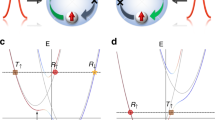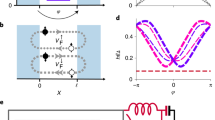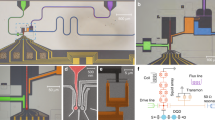Abstract
Spin qubits in semiconductors are a promising platform for producing highly scalable quantum computing devices. However, it is difficult to realize multiqubit interactions over extended distances. Superconducting spin qubits provide an alternative by encoding a qubit in the spin degree of freedom of an Andreev level. These Andreev spin qubits have an intrinsic spin–supercurrent coupling that enables the use of recent advances in circuit quantum electrodynamics. The first realization of an Andreev spin qubit encoded the qubit in the excited states of a semiconducting weak link, leading to frequent decay out of the computational subspace. Additionally, rapid qubit manipulation was hindered by the need for indirect Raman transitions. Here we use an electrostatically defined quantum dot Josephson junction with large charging energy, which leads to a spin-split doublet ground state. We tune the qubit frequency over a frequency range of 10 GHz using a magnetic field, which also enables us to investigate the qubit performance using direct spin manipulation. An all-electric microwave drive produces Rabi frequencies exceeding 200 MHz. We embed the Andreev spin qubit in a superconducting transmon qubit, demonstrating strong coherent qubit–qubit coupling. These results are a crucial step towards a hybrid architecture that combines the beneficial aspects of both superconducting and semiconductor qubits.
This is a preview of subscription content, access via your institution
Access options
Access Nature and 54 other Nature Portfolio journals
Get Nature+, our best-value online-access subscription
$29.99 / 30 days
cancel any time
Subscribe to this journal
Receive 12 print issues and online access
$209.00 per year
only $17.42 per issue
Buy this article
- Purchase on Springer Link
- Instant access to full article PDF
Prices may be subject to local taxes which are calculated during checkout




Similar content being viewed by others
Data availability
The data that support the findings of this study are publicly available via 4TU.ResearchData at https://doi.org/10.4121/c.6073271.
Code availability
The analysis code that supports the findings of this study is publicly available via 4TU.ResearchData at https://doi.org/10.4121/c.6073271.
References
Loss, D. & DiVincenzo, D. P. Quantum computation with quantum dots. Phys. Rev. A 57, 120 (1998).
Hanson, R., Kouwenhoven, L. P., Petta, J. R., Tarucha, S. & Vandersypen, L. M. K. Spins in few-electron quantum dots. Rev. Mod. Phys. 79, 1217 (2007).
Koch, J. et al. Charge-insensitive qubit design derived from the Cooper pair box. Phys. Rev. A 76, 042319 (2007).
Zwerver, A. M. J. et al. Qubits made by advanced semiconductor manufacturing. Nat. Electron. 5, 184–190 (2022).
Mi, X. et al. A coherent spin–photon interface in silicon. Nature 555, 599–603 (2018).
Samkharadze, N. et al. Strong spin-photon coupling in silicon. Science 359, 1123–1127 (2018).
Landig, A. J. et al. Coherent spin–photon coupling using a resonant exchange qubit. Nature 560, 179–184 (2018).
Borjans, F., Croot, X. G., Mi, X., Gullans, M. J. & Petta, J. R. Resonant microwave-mediated interactions between distant electron spins. Nature 577, 195–198 (2020).
Harvey-Collard, P. et al. Coherent spin-spin coupling mediated by virtual microwave photons. Phys. Rev. X 12, 021026 (2022).
Yu, C. X. et al. Strong coupling between a photon and a hole spin in silicon. Nat. Nanotechnol. https://doi.org/10.1038/s41565-023-01332-3 (2023).
Arute, F. et al. Quantum supremacy using a programmable superconducting processor. Nature 574, 505–510 (2019).
Compute Resources (IBM Quantum, accessed 13 June 2022); https://quantum-computing.ibm.com/services?services=systems
Blais, A. et al. Cavity quantum electrodynamics for superconducting electrical circuits: an architecture for quantum computation. Phys. Rev. A 69, 062320 (2004).
Wallraff, A. et al. Strong coupling of a single photon to a superconducting qubit using circuit quantum electrodynamics. Nature 431, 162–167 (2004).
Blais, A., Grimsmo, A. L., Girvin, S. & Wallraff, A. Circuit quantum electrodynamics. Rev. Mod. Phys. 93, 025005 (2021).
Chtchelkatchev, N. M. & Nazarov, Y. V. Andreev quantum dots for spin manipulation. Phys. Rev. Lett. 90, 226806 (2003).
Padurariu, C. & Nazarov, Y. V. Theoretical proposal for superconducting spin qubits. Phys. Rev. B 81, 144519 (2010).
Béri, B., Bardarson, J. H. & Beenakker, C. W. J. Splitting of Andreev levels in a Josephson junction by spin-orbit coupling. Phys. Rev. B 77, 045311 (2008).
Hays, M. et al. Coherent manipulation of an Andreev spin qubit. Science 373, 430–433 (2021).
Hays, M. et al. Continuous monitoring of a trapped superconducting spin. Nat. Phys. 16, 1103–1107 (2020).
Park, S. & Yeyati, A. L. Andreev spin qubits in multichannel Rashba nanowires. Phys. Rev. B 96, 125416 (2017).
Metzger, C. et al. Circuit-QED with phase-biased Josephson weak links. Phys. Rev. Research 3, 013036 (2021).
Nowack, K. C., Koppens, F. H. L., Nazarov, Y. V. & Vandersypen, L. M. K. Coherent control of a single electron spin with electric fields. Science 318, 1430–1433 (2007).
Nadj-Perge, S., Frolov, S. M., Bakkers, E. P. A. M. & Kouwenhoven, L. P. Spin–orbit qubit in a semiconductor nanowire. Nature 468, 1084–1087 (2010).
Bargerbos, A. et al. Singlet-doublet transitions of a quantum dot Josephson junction detected in a transmon circuit. PRX Quantum 3, 030311 (2022).
Bargerbos, A. et al. Spectroscopy of spin-split Andreev levels in a quantum dot with superconducting leads. Preprint at https://arxiv.org/abs/2208.09314 (2022).
Golovach, V. N., Borhani, M. & Loss, D. Electric-dipole-induced spin resonance in quantum dots. Phys. Rev. B 74, 165319 (2006).
van den Berg, J. W. G. et al. Fast spin-orbit qubit in an indium antimonide nanowire. Phys. Rev. Lett. 110, 066806 (2013).
Wesdorp, J. J. et al. Microwave spectroscopy of interacting Andreev spins. Preprint at https://arxiv.org/abs/2208.11198 (2022).
Pavešić, L., Pita-Vidal, M., Bargerbos, A. & Žitko, R. Impurity Knight shift in quantum dot Josephson junctions. Preprint at https://arxiv.org/abs/2212.07185 (2022).
Han, L. et al. Variable and orbital-dependent spin-orbit field orientations in an InSb double quantum dot characterized via dispersive gate sensing. Phys. Rev. Appl. 19, 014063 (2023).
Lazăr, S. et al. Calibration of drive non-linearity for arbitrary-angle single-qubit gates using error amplification. Preprint at https://arxiv.org/abs/2212.01077 (2022).
Werninghaus, M. et al. Leakage reduction in fast superconducting qubit gates via optimal control. npj Quantum Inf. 7, 14 (2021).
Stockill, R. et al. Quantum dot spin coherence governed by a strained nuclear environment. Nat. Commun. 7, 12745 (2016).
Hahn, E. L. Spin echoes. Phys. Rev. 80, 580 (1950).
Carr, H. Y. & Purcell, E. M. Effects of diffusion on free precession in nuclear magnetic resonance experiments. Phys. Rev. 94, 630 (1954).
Barthel, C., Medford, J., Marcus, C. M., Hanson, M. P. & Gossard, A. C. Interlaced dynamical decoupling and coherent operation of a singlet-triplet qubit. Phys. Rev. Lett. 105, 266808 (2010).
Bylander, J. et al. Noise spectroscopy through dynamical decoupling with a superconducting flux qubit. Nat. Phys. 7, 565–570 (2011).
Cywiński, L., Lutchyn, R. M., Nave, C. P. & Das Sarma, S. How to enhance dephasing time in superconducting qubits. Phys. Rev. B 77, 174509 (2008).
Medford, J. et al. Scaling of dynamical decoupling for spin qubits. Phys. Rev. Lett. 108, 086802 (2012).
Schreier, J. A. et al. Suppressing charge noise decoherence in superconducting charge qubits. Phys. Rev. B 77, 180502 (2008).
Braumüller, J. et al. Characterizing and optimizing qubit coherence based on SQUID geometry. Phys. Rev. Appl. 13, 054079 (2020).
Malinowski, F. K. et al. Symmetric operation of the resonant exchange qubit. Phys. Rev. B 96, 045443 (2017).
Malinowski, F. K. et al. Spectrum of the nuclear environment for GaAs spin qubits. Phys. Rev. Lett. 118, 177702 (2017).
Landig, A. J. et al. Virtual-photon-mediated spin-qubit–transmon coupling. Nat. Commun. 10, 5037 (2019).
Forn-Díaz, P., Lamata, L., Rico, E., Kono, J. & Solano, E. Ultrastrong coupling regimes of light-matter interaction. Rev. Mod. Phys. 91, 025005 (2019).
Scarlino, P. et al. In situ tuning of the electric-dipole strength of a double-dot charge qubit: charge-noise protection and ultrastrong coupling. Phys. Rev. X 12, 031004 (2022).
de Leon, N. P. et al. Materials challenges and opportunities for quantum computing hardware. Science 372, eabb2823 (2021).
Hendrickx, N. W. et al. Gate-controlled quantum dots and superconductivity in planar germanium. Nat. Commun. 9, 2835 (2018).
Scappucci, G. et al. The germanium quantum information route. Nat. Rev. Mater. 6, 926–943 (2021).
Tosato, A. et al. Hard superconducting gap in germanium. Commun. Mater. 4, 23 (2023).
Spethmann, M., Zhang, X.-P., Klinovaja, J. & Loss, D. Coupled superconducting spin qubits with spin-orbit interaction. Phys. Rev. B 106, 115411 (2022).
Acknowledgements
We acknowledge fruitful discussion with M. Veldhorst, M. Russ, F. Malinowski, V. Fatemi and Y. Nazarov. We further thank P. Krogstrup for guidance in the material growth. This research was inspired by prior work by J.J.W. where the spin-flip transition in an InAs/Al nanowire weak link was directly observed in spectroscopy under the application of a magnetic field29. This research is co-funded by the allowance for Top Consortia for Knowledge and Innovation (TKI) from the Dutch Ministry of Economic Affairs; research project ‘Scalable circuits of Majorana qubits with topological protection’ (i39, SCMQ) with project no. 14SCMQ02; the Dutch Research Council (NWO); and the Microsoft Quantum initiative. R.Ž. acknowledges support from the Slovenian Research Agency (ARRS) under P1-0416 and J1-3008. R.A. acknowledges support from the Spanish Ministry of Science and Innovation through grant PGC2018-097018-B-I00 and from the CSIC Research Platform on Quantum Technologies PTI-001. B.v.H. and C.K.A. acknowledge support from the Dutch Research Council (NWO).
Author information
Authors and Affiliations
Contributions
A.B., M.P.-V. and A.K. conceived the experiment. Y.L. developed and provided the nanowire materials. A.B., M.P.-V., L.J.S., L.G. and J.J.W. prepared the experimental setup and data acquisition tools. L.J.S. deposited the nanowires. A.B. and M.P.-V. designed and fabricated the device, performed the measurements and analysed the data, with continuous feedback from L.J.S., L.G., J.J.W., B.v.H., A.K. and C.K.A. R.A., B.v.H. and R.Ž. provided theory support during and after the measurements. A.B., M.P.-V. and B.v.H. wrote the code to compute the circuit energy levels and extract the experimental parameters. L.P.K., R.A., B.v.H., A.K. and C.K.A. supervised the work. A.B., M.P.-V. and C.K.A. wrote the paper with feedback from all authors.
Corresponding authors
Ethics declarations
Competing interests
The authors declare no competing interests.
Peer review
Peer review information
Nature Physics thanks the anonymous reviewers for their contribution to the peer review of this work.
Additional information
Publisher’s note Springer Nature remains neutral with regard to jurisdictional claims in published maps and institutional affiliations.
Supplementary information
Supplementary Information
Supplementary Sections I–III, Figs. 1–14 and Table I.
Source data
Source Data Fig. 1
Raw data.
Source Data Fig. 2
Raw data.
Source Data Fig. 3
Raw data.
Source Data Fig. 4
Raw data.
Rights and permissions
Springer Nature or its licensor (e.g. a society or other partner) holds exclusive rights to this article under a publishing agreement with the author(s) or other rightsholder(s); author self-archiving of the accepted manuscript version of this article is solely governed by the terms of such publishing agreement and applicable law.
About this article
Cite this article
Pita-Vidal, M., Bargerbos, A., Žitko, R. et al. Direct manipulation of a superconducting spin qubit strongly coupled to a transmon qubit. Nat. Phys. 19, 1110–1115 (2023). https://doi.org/10.1038/s41567-023-02071-x
Received:
Accepted:
Published:
Issue Date:
DOI: https://doi.org/10.1038/s41567-023-02071-x
This article is cited by
-
Parity-conserving Cooper-pair transport and ideal superconducting diode in planar germanium
Nature Communications (2024)
-
Phase-engineering the Andreev band structure of a three-terminal Josephson junction
Nature Communications (2023)
-
Microwave excitation of atomic scale superconducting bound states
Nature Communications (2023)
-
Hole-type superconducting gatemon qubit based on Ge/Si core/shell nanowires
npj Quantum Information (2023)



